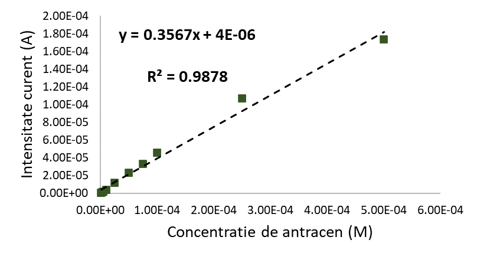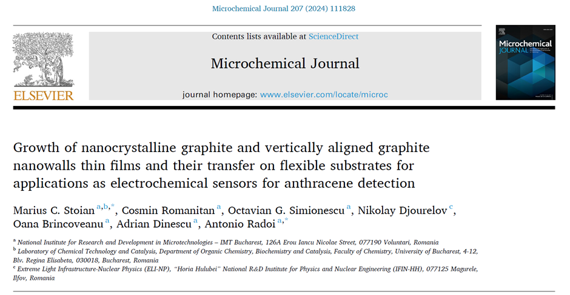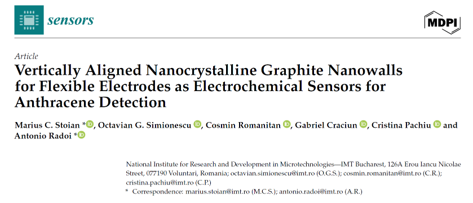
Results
Results 2024
-
PECVD growth of GNW films was realized on silicon and copper substrates at different periods (15, 30 and 45 min), evidencing an increase in carbon layer thickness with the increase in deposition time.
 |
Cross-section SEM images of the GNW films on silicon obtained at different periods during PECVD growth
-
Among the tested GNW films in the series, the flexible disposable electrode GNW 45 min/PE showed the best electrochemical sensing performance for anthracene detection, with the sensitivity of 0.3567 A/M, compared to the other GNW films with sensitivity between 0.2–0.3 A/M.
 |
Calibration curve for the anthracene detection for the flexible disposable GNW 45 min/PE electrode
2024 published paper


Results 2023
-
PECVD growth of N-doped NCG and GNW films was realized on silicon and copper substrates. For the growth of the N-doped NCG material, a dilution of ammonia gas flow (2.15 sccm) was obtained in the reaction chamber by increasing the gas flow of the precursors at 100 sccm methane and 125 sccm hydrogen.
-
GNW film showed better crystallinity and more sp2 C content than the N-NCG film, which exhibited more sp3 C content associated with amorphous regions, as inferred by XRD and XPS analysis.
-
evaluation of the NCG-based transducers has been performed by cyclic voltammetry measurements in presence of 2 mM potassium ferricyanide to reveal the electrochemical properties regarding the charge transfer of the electrodes: the lowest peak separation between the redox peaks of ferricyanide ions was observed for GNW/Si sample at 2 mV/s (DE = 61 mV), which was considerably close to the Nernstian constant (59 mV).
 |
Cyclic voltammetry measurements for the GNW/Si sample in presence of 2 mM K3[Fe(CN)6] at 2 mV/s
-
The PECVD carbonic materials grown on copper substrate were transferred on flexible polyethylene (PE) substrate to develop disposable electrode based on NCG-type materials.
-
The steps include binding of PE foils on the carbonic film and Cu foil at thermal treatment (a), followed by a chemical etching process of the Cu foil with a 1 M ferric chloride solution in a patterned PE sheet which protects a Cu square template (b), then applying resin-based layer to ensure good contact insulation from the tested solutions (c).
 |
Scheme of the development of flexible disposable electrodes based on NCG type material.
-
The flexible disposable electrode GNW/PE displayed the best electrochemical sensing performance for anthracene detection among the NCG-type material-based electrodes, with the sensitivity of 0.219 A/M and the lowest detection limit of 4.1 mM.
 |
Calibration curve for the anthracene detection for the flexible disposable GNW/PE electrode.
__________
_________________
Dissemination 2024
Publications:
- M.C. Stoian, C. Romanitan, O.G. Simionescu, N. Djourelov, O. Brincoveanu, A. Dinescu, A. Radoi, Growth of nanocrystalline graphite and vertically aligned graphite nanowalls thin films and their transfer on flexible substrates for applications as electrochemical sensors for anthracene detection, Microchem J 207 (2024) 111828. https://doi.org/10.1016/j.microc.2024.111828
- M.C. Stoian, O.G. Simionescu, C. Romanitan, G. Craciun, A. Radoi, Vertically aligned nanocrystalline graphite nanowalls for flexible electrodes as electrochemical sensors for anthracene detection, Sensors 24 (2024) 7194. https://doi.org/10.3390/s24227194.
Oral presentations:
- M.C. Stoian, O. Simionescu, C. Romanitan, G. Craciun, A. Radoi, Optimization of thickness of nanocrystalline graphite nanowalls in flexible electrochemical sensors for the detection of anthracene, 47th International Semiconductor Conference (CAS 2024), Sinaia, Romania, 9-11.10.2024.
_________________
Results 2022, December 2022
-
the growth of the transducer based on N-doped NCG material has been realized by PECVD, varying the amount of ammonia used during the growth process (2.1–3.1 sccm – standard cubic centimeters).
-
the N-doped NCG layer thickness decreases at larger volumes of ammonia introduced during the PECVD growth process, as inferred by the SEM analysis of the samples.
 |
Cross-section SEM images of the N-doped NCG samples obtained at different ammonia volumes during PECVD growth.
-
NCG with 3D nanoarchitecture (GNW) has been successfully prepared as a separate layer on NCG 2D substrate, in order to combine the attractive features for electrochemical applications of the graphite nanowalls which has high surface areas available to interact with different analyte molecules, with the conductive properties of the nanocrystalline graphite layer.
|
|
SEM image of the GNW material grown on the NCG 2D layer by PECVD. |
-
evaluation of the NCG-based transducers has been performed by cyclic voltammetry measurements in presence of ferrocyanide ions to reveal the electrochemical properties regarding the charge transfer of the electrodes.
-
a lower separation of the redox peaks in CV measurements is indicative of a high charge transfer which can be observed for the GNW + NCG sample compared to the N-doped NCG sample obtained with the lowest amount of ammonia used during the PECVD growth process.
-
the GNW material deposited on NCG 2D layer shows high potential with regard to the electrochemical properties required for PAH detection and quantification, whereas more options to improve by doping with heteroatoms are available.
|
Cyclic voltammetry measurements for the N-NCG-A sample (with the lowest amount of ammonia used in PECVD – orange plot) and the GNW material grown on NCG 2D (violet plot).
DISSEMINATION
Oral presentations:
Surface functionalization of graphitized porous silicon with cobalt hexacyanoferrate nanocubes for hybrid electrode in high-performance supercapacitors, M.C. Stoian, I.-N. Bratosin, C. Romanitan, G. Craciun, N. Djourelov, M. Kusko, A. Radoi, The 45th International Semiconductor Conference (CAS 2022), Poiana Brașov, Romania, 12-14 October 2022
______________
Estimated results
- Achieving the nitrogen doping process of the grown carbon films to reach the desired concentration of the heteroatom in the lattice;
- Growth of nitrogen-doped NCG films onto different substrates in 3D nanoarchitecture scaffold;
- Ready-to-use electrochemical devices based on the developed NCG films for detection of anthracene and other electroactive PAHs;
- Supporting collaboration between academia and national research institutes, to promote innovation and technology transfer towards potential industrial partners.



